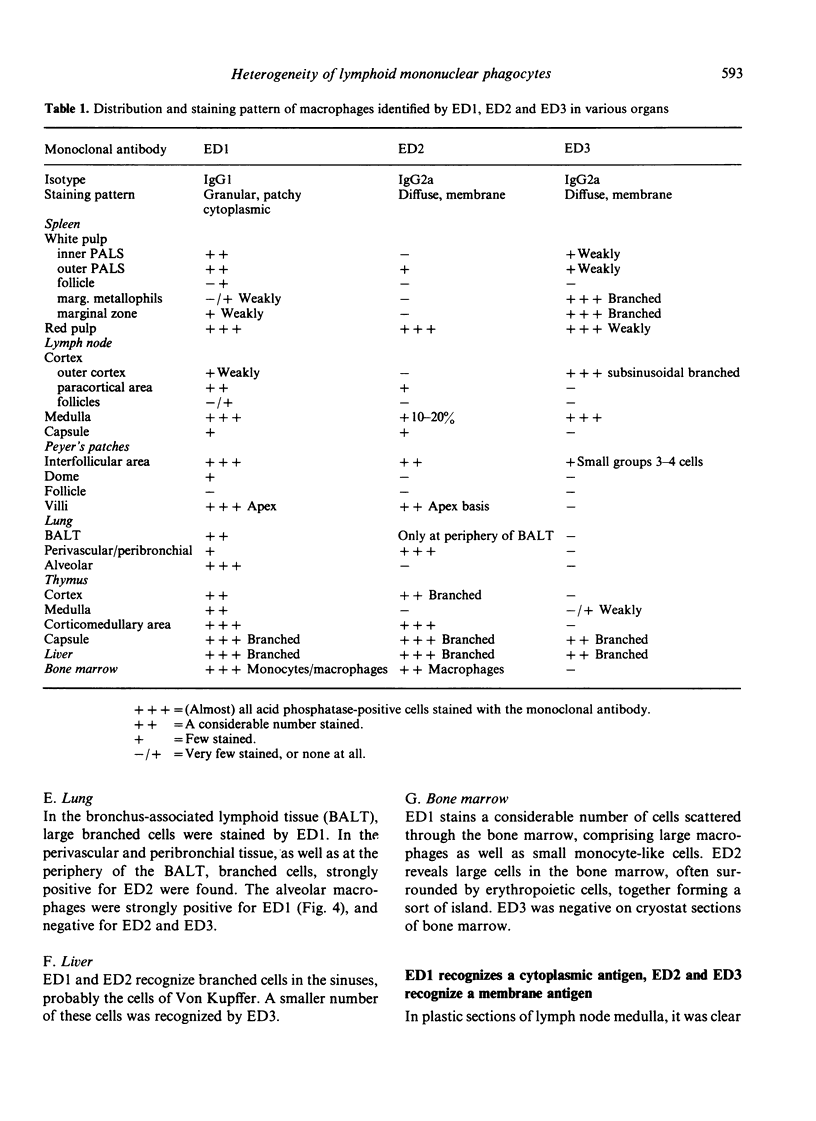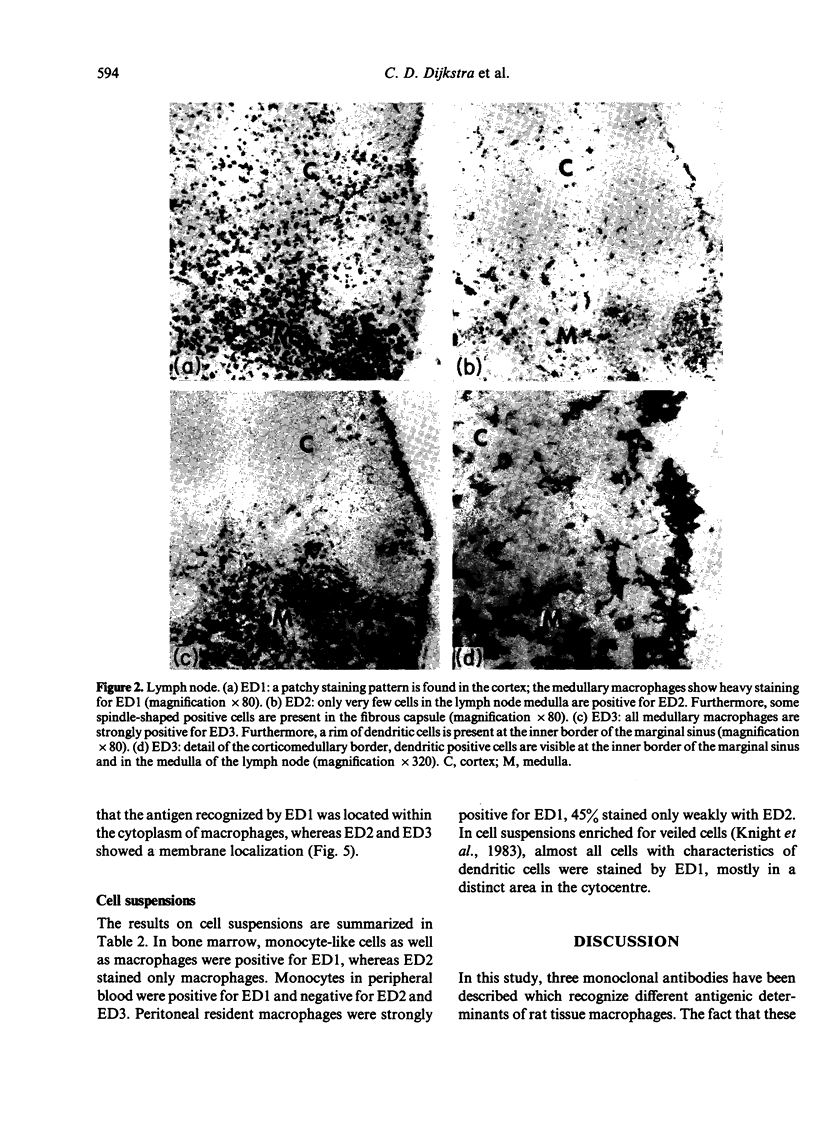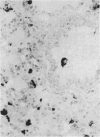Abstract
In the present study, a set of three monoclonal antibodies is described, each of which recognizes cells of the monocyte-macrophage lineage in the rat. The tissue distribution, in particular in lymphoid organs, of each of the three monoclonals is determined by immunoenzyme histochemistry on cryostat sections, as well as on cell suspensions. Results show that ED1 recognizes a cytoplasmic antigen in monocytes and in most macrophages, free and fixed. ED2 and ED3 recognize membrane antigens of tissue macrophages, discriminating between distinct subpopulations of macrophages, each with a characteristic localization in the compartments of lymphoid organs. No other cell types except cells of the mononuclear phagocyte system are positive for any of the three monoclonals. Possible relations between the macrophages recognized by this set of monoclonals and dendritic cells are discussed.
Full text
PDF










Images in this article
Selected References
These references are in PubMed. This may not be the complete list of references from this article.
- Barclay A. N. Different reticular elements in rat lymphoid tissue identified by localization of Ia, Thy-1 and MRC OX 2 antigens. Immunology. 1981 Dec;44(4):727–736. [PMC free article] [PubMed] [Google Scholar]
- Barclay A. N. The localization of populations of lymphocytes defined by monoclonal antibodies in rat lymphoid tissues. Immunology. 1981 Apr;42(4):593–600. [PMC free article] [PubMed] [Google Scholar]
- Beller D. I., Unanue E. R. Thymic macrophages modulate one stage of T cell differentiation in vitro. J Immunol. 1978 Nov;121(5):1861–1864. [PubMed] [Google Scholar]
- Bursuker I., Goldman R. On the origin of macrophage heterogeneity: a hypothesis. J Reticuloendothel Soc. 1983 Mar;33(3):207–220. [PubMed] [Google Scholar]
- COHN Z. A., BENSON B. THE DIFFERENTIATION OF MONONUCLEAR PHAGOCYTES. MORPHOLOGY, CYTOCHEMISTRY, AND BIOCHEMISTRY. J Exp Med. 1965 Jan 1;121:153–170. doi: 10.1084/jem.121.1.153. [DOI] [PMC free article] [PubMed] [Google Scholar]
- Calderon J., Unanue E. R. Two biological activities regulating cell proliferation found in cultures of peritoneal exudate cells. Nature. 1975 Jan 31;253(5490):359–361. doi: 10.1038/253359a0. [DOI] [PubMed] [Google Scholar]
- Cohn Z. A. Activation of mononuclear phagocytes: fact, fancy, and future. J Immunol. 1978 Sep;121(3):813–816. [PubMed] [Google Scholar]
- Dijkstra C. D. Characterization of nonlymphoid cells in rat spleen, with special reference to strongly Ia-positive branched cells in T-cell areas. J Reticuloendothel Soc. 1982 Sep;32(3):167–178. [PubMed] [Google Scholar]
- Dijkstra C. D., Kamperdijk E. W., Döpp E. A. The ontogenetic development of the follicular dendritic cell. An ultrastructural study by means of intravenously injected horseradish peroxidase (HRP)-anti-HRP complexes as marker. Cell Tissue Res. 1984;236(1):203–206. doi: 10.1007/BF00216532. [DOI] [PubMed] [Google Scholar]
- Flotte T. J., Springer T. A., Thorbecke G. J. Dendritic cell and macrophage staining by monoclonal antibodies in tissue sections and epidermal sheets. Am J Pathol. 1983 Apr;111(1):112–124. [PMC free article] [PubMed] [Google Scholar]
- Gerdes J., Stein H., Mason D. Y., Ziegler A. Human dendritic reticulum cells of lymphoid follicles: their antigenic profile and their identification as multinucleated giant cells. Virchows Arch B Cell Pathol Incl Mol Pathol. 1983;42(2):161–172. doi: 10.1007/BF02890379. [DOI] [PubMed] [Google Scholar]
- Haines K. A., Flotte T. J., Springer T. A., Gigli I., Thorbecke G. J. Staining of Langerhans cells with monoclonal antibodies to macrophages and lymphoid cells. Proc Natl Acad Sci U S A. 1983 Jun;80(11):3448–3451. doi: 10.1073/pnas.80.11.3448. [DOI] [PMC free article] [PubMed] [Google Scholar]
- Hume D. A., Robinson A. P., MacPherson G. G., Gordon S. The mononuclear phagocyte system of the mouse defined by immunohistochemical localization of antigen F4/80. Relationship between macrophages, Langerhans cells, reticular cells, and dendritic cells in lymphoid and hematopoietic organs. J Exp Med. 1983 Nov 1;158(5):1522–1536. doi: 10.1084/jem.158.5.1522. [DOI] [PMC free article] [PubMed] [Google Scholar]
- Humphrey J. H., Grennan D. Different macrophage populations distinguished by means of fluorescent polysaccharides. Recognition and properties of marginal-zone macrophages. Eur J Immunol. 1981 Mar;11(3):221–228. doi: 10.1002/eji.1830110311. [DOI] [PubMed] [Google Scholar]
- Knight S. C., Mertin J., Stackpoole A., Clark J. Induction of immune responses in vivo with small numbers of veiled (dendritic) cells. Proc Natl Acad Sci U S A. 1983 Oct;80(19):6032–6035. doi: 10.1073/pnas.80.19.6032. [DOI] [PMC free article] [PubMed] [Google Scholar]
- Köhler G., Milstein C. Continuous cultures of fused cells secreting antibody of predefined specificity. Nature. 1975 Aug 7;256(5517):495–497. doi: 10.1038/256495a0. [DOI] [PubMed] [Google Scholar]
- Morahan P. S. Macrophage nomenclature: where are we going? J Reticuloendothel Soc. 1980 Feb;27(2):223–245. [PubMed] [Google Scholar]
- SNOOK T. STUDIES ON THE PERIFOLLICULAR REGION OF THE RAT'S SPLEEN. Anat Rec. 1964 Feb;148:149–159. doi: 10.1002/ar.1091480205. [DOI] [PubMed] [Google Scholar]
- Shaklai M., Tavassoli M. Cellular relationship in the rat bone marrow studied by freeze fracture and lanthanum impregnation thin-sectioning electron microscopy. J Ultrastruct Res. 1979 Dec;69(3):343–361. doi: 10.1016/s0022-5320(79)80052-0. [DOI] [PubMed] [Google Scholar]
- Sorg C. Heterogeneity of macrophages in response to lymphokines and other signals. Mol Immunol. 1982 Oct;19(10):1275–1278. doi: 10.1016/0161-5890(82)90293-0. [DOI] [PubMed] [Google Scholar]
- Steinman R. M., Nussenzweig M. C. Dendritic cells: features and functions. Immunol Rev. 1980;53:127–147. doi: 10.1111/j.1600-065x.1980.tb01042.x. [DOI] [PubMed] [Google Scholar]
- Streefkerk J. G., van der Ploeg M. The effect of methanol on granulocyte and horseradish peroxidase quantitatively studied in a film model system. Histochemistry. 1974;40(2):105–111. doi: 10.1007/BF00495959. [DOI] [PubMed] [Google Scholar]
- Twomey J. J., Laughter A., Brown M. F. A comparison of the regulatory effects of human monocytes, pulmonary alveolar macrophages (PAMs) and spleen macrophages upon lymphocyte responses. Clin Exp Immunol. 1983 May;52(2):449–454. [PMC free article] [PubMed] [Google Scholar]
- Veerman A. J. On the interdigitating cells in the thymus-dependent area of the rat spleen: a relation between the mononuclear phagocyte system and T-lymphocytes. Cell Tissue Res. 1974 Apr 11;148(2):247–257. doi: 10.1007/BF00224586. [DOI] [PubMed] [Google Scholar]
- Villena A., Zapata A., Rivera-Pomar J. M., Barrutia M. G., Fonfria J. Structure of the non-lymphoid cells during the postnatal development of the rat lymph nodes. Fibroblastic reticulum cells and interdigitating cells. Cell Tissue Res. 1983;229(1):219–232. doi: 10.1007/BF00217894. [DOI] [PubMed] [Google Scholar]
- Walker W. S. Functional heterogeneity of macrophages in the induction and expression of acquired immunity. J Reticuloendothel Soc. 1976 Jul;20(1):57–65. [PubMed] [Google Scholar]
- van Furth R., Cohn Z. A., Hirsch J. G., Humphrey J. H., Spector W. G., Langevoort H. L. The mononuclear phagocyte system: a new classification of macrophages, monocytes, and their precursor cells. Bull World Health Organ. 1972;46(6):845–852. [PMC free article] [PubMed] [Google Scholar]







